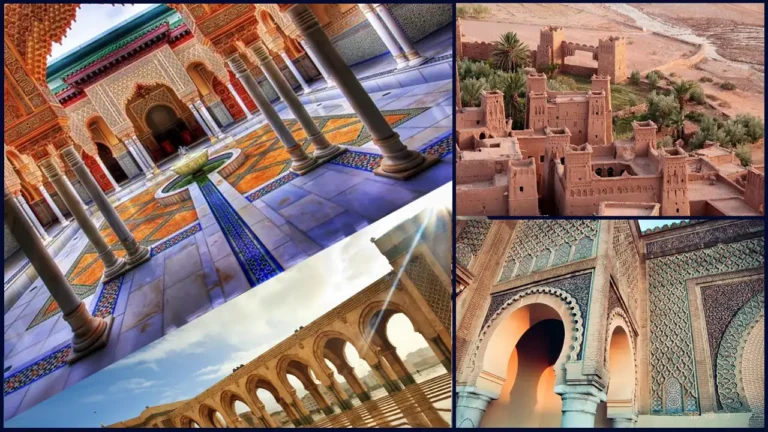Moroccan Art: From Handcrafted Ceramics to Vibrant Textiles
Moroccan art is more than visual objects. It’s a living testament to the country’s rich history and cultural diversity. From the intricate mosaics that decorate old medinas to the contemporary paintings hanging in modern galleries, Moroccan artistic ornaments tell stories inherited from Berber traditions, Islamic influences, and European nuances.
Whether you’re drawn to the vibrant colors of zellige tiles, the symbolic patterns of Berber rugs, or the bold creativity of Morocco’s emerging artists, the country’s artistic tapestry offers something for every traveler to admire. Moroccan art invites you to explore not only its aesthetic beauty but also the deeper cultural roots that make it a defining part of Morocco’s identity.
Table of Contents
The Evolution of Moroccan Art
Moroccan art started simple. In Berber villages, people made what they needed—pots, rugs, and jewelry. But these weren’t just everyday things. Each one had meaning. A rug might tell a story about the weaver’s family or the land they lived on. The patterns were bold, the colors earthy, like the mountains and deserts around them.
When Islam arrived, everything changed. New ideas came with it. People started using tiles—small, colorful pieces—to make big, beautiful mosaics. These tiles, called zellige, ended up on walls, fountains, and floors. And then there was calligraphy. Artists turned Arabic words into decorations, carving them into wood or painting them on tiles.
Morocco didn’t stay the same over time. Traders brought new things, new styles. You can see bits of Spain, Africa, and the Middle East in Moroccan art. Even now, when you walk through a market, it feels like every piece has a little of that history in it—old and new, mixed together.
Timeless Traditional Crafts
Crafts in Morocco are everywhere, but they’re not just things to sell—they mean something. Zellige tiles, for example, are tiny, colorful pieces that craftsmen cut and fit together by hand. You see them on walls, fountains, and even on tables. It looks simple when you walk past, but making them takes years of practice.
Berber rugs are another story. They’re not just made for the floor. Each rug has symbols, like shapes or patterns, that mean something—maybe about family, or the land, or protection. It’s not fast work, either. Sometimes one rug can take months to finish, all done by hand.
Jewelry is hard to miss in Morocco. The silver necklaces, bracelets, and rings stand out, sometimes with big stones like amber. These aren’t just for wearing; they’re used in weddings and festivals. They’ve been part of life here for a long time, and every piece feels like it has a story behind it.
Iconic Moroccan Art Forms
Moroccan art is all about details. Zellige tiles are one of the best examples. These tiles are cut by hand, really small, and then put together to make big patterns. You can find them on fountains, walls, and even floors. It’s not quick work—it takes a lot of time and skill.
Calligraphy is also really important in Moroccan art. It’s not just writing. The way the Arabic letters curve and connect turns it into something beautiful. Sometimes you see it carved into wood or painted on plates. It’s more than decoration—it feels like part of the culture.
Fabrics are another big thing. Whether it’s a scarf, a pillow, or a piece of clothing, the patterns tell a story. They come from old traditions, and you can see the care that goes into making them. Everything feels like it has a meaning.
The Role of Souks in Art
Souks are where Moroccan art comes alive. They’re loud, busy, and full of colors. Craftsmen sit in their small shops, working with their hands—cutting leather, carving wood, or painting pottery. You can watch them work right there.
In places like the Marrakech souks, you see all kinds of things: rugs, lanterns, jewelry, and painted plates. Sometimes sellers tell stories about their items—maybe where they’re from or how they’re made. You never know if it’s true, but it makes the shopping more fun.
The souks aren’t just markets; they’re like museums where everything is alive. The people working there are keeping old skills and traditions going, passing them to the next generation. Even if you don’t buy anything, just walking through feels like seeing Moroccan art in action.
Modern Moroccan Art
Moroccan art isn’t just about the old things. Today, artists are doing something new. In cities like Rabat or Casablanca, you can find galleries showing paintings or sculptures that look very different from the traditional stuff.
Some artists still use ideas from the past. You might see designs that remind you of Berber rugs or zellige tiles, but they’re done in a modern way. Other artists make things that are totally new—bright colors, strange shapes, and ideas that surprise you.
If you want to see this kind of art, check out places like the Mohammed VI Museum in Rabat. It’s where you can see how Moroccan art is changing, but it still feels like it belongs to Morocco. It shows that art here is always moving, always growing.
Cultural and Daily Significance of Moroccan Art
In Morocco, art is part of everyday life. You see it in the rugs people sit on, the patterns on walls, or even in the way tea glasses are decorated. It’s not just for show—it’s everywhere, and it means something.
A lot of the designs have stories. A rug might have shapes that stand for good luck, or a door might be carved with patterns that connect to faith or nature. These aren’t just pretty—they’re part of life and history.
Art also brings people together. At weddings or festivals, you see henna on hands, hear traditional music, and watch people dancing. It feels like everyone is part of something bigger. That’s what makes Moroccan art special—it’s not separate from life. It is life.






